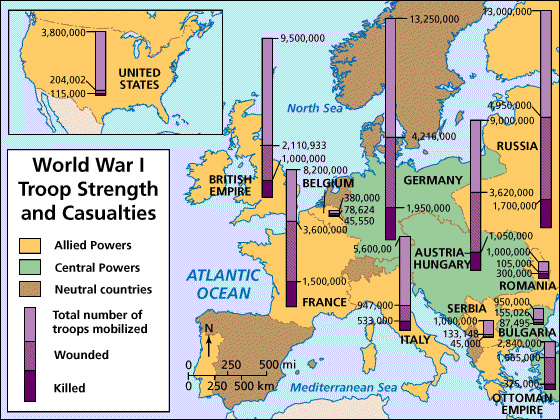
Which of the following Allied Powers had the highest number of total casualties in World War I?
A. France
Incorrect. France had the 2nd highest percentage of deaths.
B. Germany
Incorrect. Germany was a member of the Central Powers.
C. Russia
Correct!
D. United States
Incorrect. The United States only accounted for 2% of the casualties.
The technology of World War I completely changed warfare for future generations. How?
A. Weaponry was more accurate than ever before.
Incorrect. Often the weapons (such as the machine gun) were inaccurate, but could broadly be used to kill many forces.
B. The weapons were able to kill large numbers of enemy troops quickly.
Correct!
C. The weapons used were made by hand.
Incorrect. For the first time many weapons were mass-produced in assembly lines and factories.
D. The large weapons were fast moving and easy to operate.
Incorrect. Things like the U-Boat and the tank were slow and hard to move from location to location.
Which of the following is an example of a cause and effect relationship that can be seen in the development of the weapons of World War I?
A. The use of mustard gas and other biotoxins led to the development of gas masks as a form of protection.
Correct!
B. Trenches were dug as a way for troops to hide from tanks.
Incorrect. The trenches were dug as a way to offer soldiers protection from rapid fire artillery.
C. The use of machine guns forced troops to stay in trenches and not move around on the battlefield.
Incorrect. Both sides would regularly charge at each other across the no man’s land between the trenches.
D. German forces designed U-Boat submarines to ship supplies across the Atlantic Ocean.
Incorrect. The U-Boats were designed to destroy enemy supply ships.
World War I became a war of attrition. What does this idea mean?
A. Both sides fight against one another in a slow process that can take years. Each side basically tries to outlast the other.
Correct!
B. One side is much stronger than the other, eliminating the opponent quickly.
Incorrect. This is the exact opposite of a war of attrition. Try again!
C. The two opposing sides eventually started using each others' strategies, and began fighting towards the same goal.
Incorrect. This did not happen in World War I.
D. The opposing sides eventually decide on a cease fire together, giving up the fighting.
Incorrect. This did not happen in World War I.

Using the map above, which two allied countries casualty total (killed and wounded) equaled just over that of Germany?
A. France and Great Britain
Incorrect. France and Great Britain had 2,500,000 casualties, Germany had 1,950,000. This is not the best answer.
B. Russia and Romania
Correct! Russia and Romania had 2,000,000 casualties – just over Germany’s with 1,950,000.
C. Serbia and Italy
Incorrect. Serbia and Italy had 578,000 casualties, Germany had 1,950,000. This is not the best answer.
D. United States and France
Incorrect. The United States and France had 1,615,000 casualties. Germany had 1,950,000 casualties. This is not the best answer.